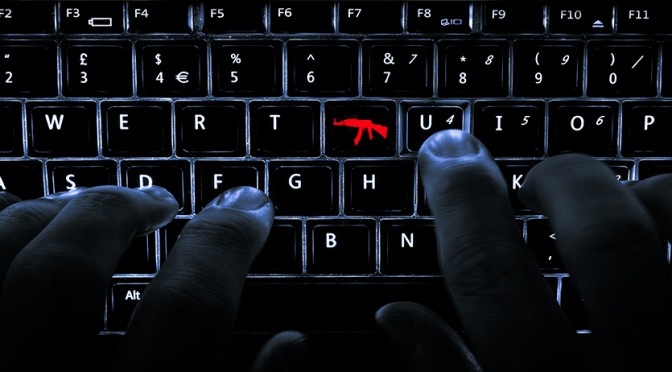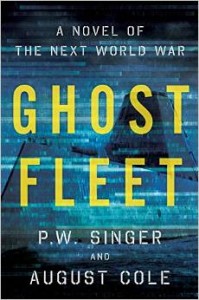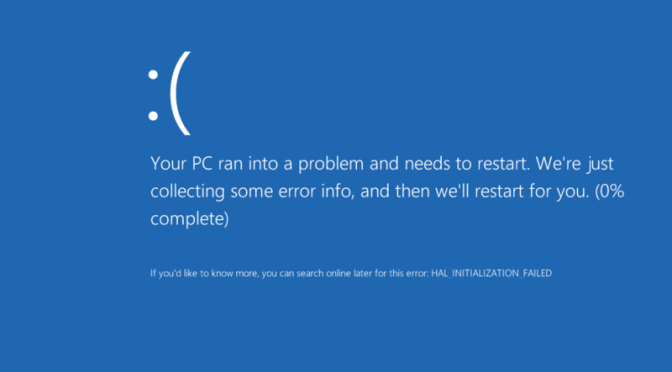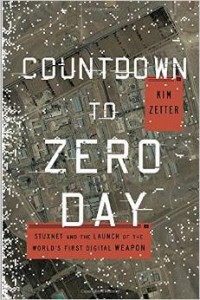Ghost Fleet. P.W. Singer & August Cole, (2015). Houghton Mifflin Harcourt. New York, NY: 404 pp. $28.00.
Review by Brett J. Patron
If you’ve ever wondered what an operationalized version of Eisenhower’s “military industrial complex” might look like, noted national security analysts Peter W. Singer and August Cole have a book just for you. A true triad of military, bureaucrats, and corporations overthrows a long-running government to form an uneasy alliance to run a rather large country. Singer and Cole throw us the first of many curves by teeing this up, not in the US, but China…or, as they now call themselves, “The Directorate.”
This first fiction effort by the duo delivers wide-ranging action at a frenetic pace. The story begins in outer space and, in mere moments, the action plunges far below the Pacific Ocean’s surface. Throughout the story, as venues change, the reader gasps for breath and delves back in as the action continues. This is a Tom Clancy-esque thriller with most of the pieces one would expect: people unexpectedly thrust into difficult situations; well-researched, accurate portrayals of current capabilities; imaginative exploration of new, emerging, or desired technology; as well as good old fashioned palace intrigue and political gamesmanship.
For those making the Clancy connection, you’ll find this book of the Red Storm Rising genre — a look at how a world war type scenario would likely go. Ghost Fleet looks at how the “Pivot to Asia” could go – and it can go bad pretty fast. It also plays on many of the fears that serious analysts ponder regarding military procurements, military readiness and other economic tradeoffs. Buoyed by the massive changes spurred by their recent revolution, the Directorate decides that it is time to achieve their “Manifest Destiny” in the Pacific. A major energy discovery gives them the opportunity to challenge US supremacy in the Pacific and even take on the US militarily, with the tacit assistance of Russia.
What ensues is a massive and coordinated sneak attack that cripples US capabilities throughout the Pacific Rim, most notably in Hawaii. The Directorate, now occupying US sovereign territory and positioned to prevent response either from space or across the vast ocean, looks to turn America into a third-rate client state. To counter this the US decides to reactivate ships (and some aircraft) mothballed by the significant cuts that US politicians foisted upon itself. This is the rebirth of the Ghost Fleet that gives this story its name. It also evokes a slightly different comparison: this is the Navy’s version of “Team Yankee.” Team Yankee was a very popular “must read” in the late 1980s, especially popular with the mechanized/armor community of the Army. It is about warfare at its base level, but with existential impact. In this case, the crew of a one-of-a-kind ship, which was rejected by the Navy when cuts were made, is being brought back to life by a crew desperately trying to make it work in trying circumstances and fights the battle of its life for a noble cause.
Singer and Cole introduce a number of characters: A navy officer whose transition to retirement is rather violently interrupted; a Marine thrust into the role of guerrilla; a Sun Tzu-quoting Chinese admiral; and a seductive assassin. The story explores the very tempestuous relationship between father and son bonded in a moment of crisis while wrestling with demons of the past. The duo’s style offers some nice bonuses. The reader gets a murder mystery. The idea of “privateers” in the 21st Century is presented. For the geopolitical thinkers, Singer and Cole skewer a lot of the shibboleths of current alliances and ask “who will really ‘step up’ when the going gets tough?” The authors present some very interesting ideas of what could happen and what could emerge if all the geopolitical knowns were to suddenly change. Rather than distract, these threads are woven into a complex but compelling story that is both provocative and frightening.
What this book does do well — and in a scary way — is show how pervasive a wired world could be and what would happen if a major actor were to severely upset the proverbial apple cart. Among the discoveries in the opening salvos of The Directorate’s aggression are the vulnerability of so much of the electronics used both in military equipment as well as the networks that course through the US. Ghost Fleet explores the extent to which autonomous systems change life and warfare. Can we trust the electronics we buy from overseas? Do we depend too much on automatic, autonomous and “linked” systems in our basic and daily lives? What if a major competitor played on those fears with ruthless precision and execution? This will confirm the worst fears of the Luddite or conspiracy theorist. Those that are on the fence about the impact of autonomous systems will likely find that this book tips them one way or the other.
Two things that one would expect to find in such styled books are not found in this one. One is probably the book’s only serious flaw. The story does not give time stamps and the reader may not realize that the scenario has advanced in time as it changes chapter. Without this context, the reader may become confused on why or how things changed so fast within the story.
The other creative difference is a positive: there is very little discussion of the machinations of the American politicians. Singer and Cole — in a choice very likely calculated to avoid the politics of the moment — do not really describe much, if anything about the moves, motives, or response of the President, or most of the national security apparatus. While the Secretary of Defense is omnipresent, no one else is — nor are there any real discussions on national politics at play. Some may be greatly disappointed by this while others may find it a welcome departure in the genre. Although cyberspace capabilities are a significant aspect of the storyline, this is not a book about “cyber war.”
If anything, this is may be the first real exploration of Demchakian “cybered conflict” in story form. Cybered Conflict is a construct provided by Naval War College professors Chris Demchak and Peter Dombrowski. The premise is that the nature of conflict remains the same but that cyberspace capabilities add a new dimension. They further purport that cyberspace is not a separate domain, per se, but is instead just another aspect of how humans interact and compete. Cyberspace is itself not decisive but can certainly tip the scale in an existential conflict. There are ample examples in this book on how this could occur. It is certain to ignite debate on the nature of “cyber war.”
Thriller readers will find this a welcome addition to their collections. Thinkers, advocates, policy wonks, geeks and nerds will all find something to chew on that will confirm or challenge their own biases. Scheduled for a June release, this highly recommended story is a daring look at the fusion of traditional and modern warfare, delivered at “machine speed.”
Brett Patron retired from the US Army after serving twenty-two years with Special Forces, Special Operations, Infantry, and Signal Corps units. After retirement, he’s worked as a defense analyst, supporting Navy, Army, Marine, Special Operations, Joint and Cyberspace organizations. He is now an independent consultant, focused on cyberspace capabilities integration, doctrine development, and policy/law. He makes his home in Yorktown, Virginia.
Readers interested in reviewing books for CIMSEC can e-mail the book review editor at books@cimsec.org.









 Sea Control discusses the Crimean Crisis, with three CIMSEC writers:
Sea Control discusses the Crimean Crisis, with three CIMSEC writers: